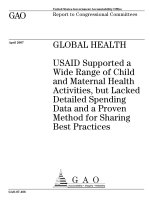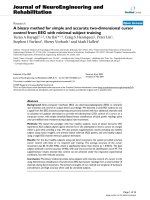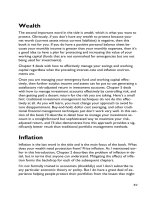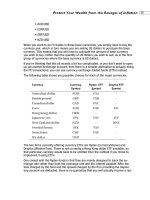everyone is a customer a proven method for measuring the value of every relationship in the era of collaborati phần 6 potx
Bạn đang xem bản rút gọn của tài liệu. Xem và tải ngay bản đầy đủ của tài liệu tại đây (366.72 KB, 24 trang )
wide open. You’ve analyzed the situation, know the pluses and
minuses, and made your decision. You are still managing the re-
lationship. You are still in control, even though the decision was
made more with your heart than your wallet.
ITERATING A RELATIONSHIP
In the previous chapter we talked about how our friend
Dave went about changing the nature of his relationship with his
landlord, Max, from one that was transactional to one that was
collaborative. We also demonstrated that changing the relation-
ship was a process. After Dave demonstrated to Max the oppor-
tunity to derive mutual strategic benefit by iterating their
relationship, Max committed a few resources (printing flyers). If
Max’s tenants responded, Dave would offer discounted services
and then begin to pay Max. Who knows where the relationship
could go from there. But what we do know is that it takes a num-
ber of interactions for Dave and Max to iterate their relationship
to the desired category. And, of course, both Dave and Max are
aware that the value proposition underlying their new collabo-
rative relationship will continue to change over time, iteration
after iteration, as their respective goals and currencies change.
But if you stand back from the details, what we really see tak-
ing place is an example of trading in relationship currencies. When
Dave decides to approach Max about offering his services to Max’s
tenants, essentially Dave is envisioning where their relationship
can go and then setting about bringing that vision to fruition.
Let’s take a closer look at the process Dave is using to trans-
form the relationship. Dave asks himself two questions about the
current status of his relationship with Max:
1. Is Max currently assisting me in achieving any of my im-
portant goals?
96 Part Two
❘
Purposeful Collaboration
2. Is my relationship with Max intensive?
As we know, the answer to both questions is no. But Dave doesn’t
stop there. He then asks two additional questions:
3. Could Max assist me in achieving my goals by providing
any currencies that I need?
4. Could I give Max any currencies that will help him
achieve his goals?
Again, as we know, this time Dave answers both of these ques-
tions with a yes. As the story unfolds, we see that Dave and Max
reach a new value proposition in which both receive a currency
from the other that they were not previously receiving. Dave gets
access to potential customers (Max’s tenants) and Max offers ad-
ditional services to his tenants (Dave’s shipping and logistics ser-
vices as well as Myer’s messenger service), thus generating an
additional revenue stream.
Now that we understand the steps Dave followed to iterate
his relationship with Max, let’s take a look at the process in a
more general sense.
FOUR QUESTIONS
If we start with the four questions that Dave asked himself
relative to his relationship with Max, we can then reword them
to work for all of your relationships:
Current Relationship Assessment
1. Is this person currently assisting me in achieving any of
my goals by providing me with currencies that add
strategic value?
6
❘
Deciding Who to Dance With 97
2. Is the rhythm of this relationship intensive?
Future Relationship Assessment
3. Could this person provide me with currencies that add
strategic value by helping me achieve any of my goals?
4. Could I offer currencies to this person that will help this
person achieve his or her goals?
As you can see, just as Dave did in his relationship with
Max, we have two questions that assess the current state of the
relationship and two additional questions that envision how po-
tential currencies offered or received can change the relation-
ship. By answering these four questions about every business
relationship and using the grid in Figure 6.1, you can segment
your relationships into one of the nine different relationship sce-
nario categories shown.
❚ Answering four questions about every business relation-
ship segments them into one of nine different relationship sce-
nario categories.
In developing these relationship scenarios, we made the un-
derlying assumption that we will only consider options that move
relationships up and to the right. Unless you are trying to move
a relationship from a resource sink to the transactional category
and thereby free up time, energy, and currencies, we assume that
you will derive greater value from moving a relationship from
non-core to core and from non-intensive to intensive. We also as-
sume that an intensive relationship remains intensive unless you
take specific action to change the level of intensity. Given these as-
sumptions, if your answer to question 1 is “Yes,” then the answer
to question 3 will be “Yes.” Also, if your answer to question 2 is
“Yes,” then the answer to question 4 will be “Yes.” Consequently,
Figures 6.1 and 6.2 show the nine scenarios on which to focus
98 Part Two
❘
Purposeful Collaboration
based on these assumptions, as opposed to all 16 possible combi-
nations of Yes/No answers to the four questions.
ALTERNATIVE SCENARIOS
As you can see in Figure 6.2, given our assumptions, these
four questions result in defining the two different types of rela-
tionship scenarios represented on the matrix by either an arrow
or an asterisk. First, let’s look at the four scenarios denoted with
an asterisk and a letter: *A, *E, *G, and *I. These four scenarios
represent relationships for which the current quadrant and future
quadrant are the same. They are relationships that do not move
to another quadrant because you cannot identify a change in the
6
❘
Deciding Who to Dance With 99
FIGURE 6.1
❘
The Four Questions
currencies you are currently giving or receiving. For example, *E
denotes a relationship that is currently a resource opportunity
and for which its future state is also a resource opportunity be-
cause you haven’t yet figured out a way to take advantage of the
opportunity or you are not yet in the position to commit the re-
sources necessary to take advantage of the opportunity. In addi-
tion to the four scenarios that stay in the same category, five
relationship scenarios are represented by arrows. These scenar-
ios represent relationships that have the potential to move from
one relationship category to another based on your answers to
questions 3 and 4. For example, Scenario B represents a relation-
ship that is currently a resource sink but has the potential over
time to move to a collaborative relationship. Again, it is impor-
100 Part Two
❘
Purposeful Collaboration
FIGURE 6.2
❘
Relationship Scenario Matrix
tant to stress that it may take a number of iterations to move a re-
lationship from its current category to its future category.
We’ll talk more about how relationships iterate over time
after we take a closer look at what each of these nine relationship
scenarios means:
Scenario A: Collaborative Relationship. Arelationship that has
a continuous bidirectional flow of currencies of core value to
both parties. Again, collaborative relationships are built over
time and are based on trust and mutual benefit.
Scenario B: Critical Collaborative Opportunity. Arelationship
that, although currently a resource sink, has the potential to iter-
ate into a collaborative relationship. However, if you do not see
the possibility of receiving currencies of core value in a reason-
able time, reduce your resource commitment and thereby move
the relationship into the transactional quadrant.
Scenario C: Potential Collaborative Opportunity. A transactional
relationship you believe can and should iterate into a mutually
beneficial collaborative relationship. Remember that some rela-
tionships work better at the transactional level so you don’t have
to turn all transactional relationships into collaborative ones.
Scenario D: Collaborative Opportunity. Arelationship that
starts as a resource opportunity but has the potential to move to
collaboration. In this scenario, you see an opportunity to provide
currencies of core value to the other party, thereby allowing you
to continue to receive currencies of core value to you.
Scenario E: Resource Opportunity. A current relationship you
see remaining as a resource opportunity. However, remember
that a resource opportunity relationship is not a viable long-term
situation because of the unbalanced nature (win-lose) of the cur-
rent value proposition. Unless you turn it into a collaborative
6
❘
Deciding Who to Dance With 101
relationship, you may lose the currencies you are receiving from
the other party.
Scenario F: Long Shot. Arelationship that starts as a transac-
tional one but has the potential to become a resource opportunity
as you believe you can receive currencies of core value. However,
a resource opportunity is not a viable long-term relationship be-
cause of the win-lose value proposition, so you must decide what
you can give as well as receive to establish a core relationship.
Scenario G: Resource Sink. Arelationship that you expect
will remain a resource sink. Even though resource sink relation-
ships consume a lot of your resources as a result of the intensive
nature of their rhythm, they do not provide you with currencies
of core value. Consequently, if you cannot raise the value of the
currencies you are receiving, you should reduce your resource
commitment and move the relationship into the transactional
quadrant.
Scenario H: Potential Resource Sink. Arelationship that is
moving from the transactional to the resource sink quadrant,
which may not be a desirable change given the resulting drain
on resources. As such, you need to be very purposeful before al-
lowing any of your relationships to become resource sinks.
Scenario I: Transactional Relationship. Arelationship that is,
and will continue to be, transactional. Transactional relation-
ships are a viable state and for many relationships are exactly
suited to their purpose because they consume so few resources.
THE RELATIONSHIP DANCE
Throughout this chapter we have talked about moving re-
lationships from one relationship quadrant to a more desirable
102 Part Two
❘
Purposeful Collaboration
quadrant, as Dave did with Max. We have also said that it will
most often take you several interactions before your relationship
reaches the desired new category. And although the arrows in
Figure 6.2 are drawn as straight lines, it is more likely that the
interaction-by-interaction “dance” between you and the other
party will not follow a straight line.
❚ The interaction-by-interaction dance will not follow a straight
line as the relationship iterates to a more desirable scenario.
Let’s go back to the Dave and Max example. If you recall,
Dave took the lead by approaching Max with his concept of how
they might provide additional benefit (currencies) to each other.
That is, Dave first offered his services to Max’s tenants, so Dave
provided his currency before Max responded in kind. Max could
have learned from Dave and then taken Dave’s ideas to another
vendor. Because Dave offered his currency first, the actual path
their dance took wasn’t a direct line from transactional to collab-
orative as reflected by arrow C. In reality, the relationship fol-
lowed the path (transactional–resource sink–collaborative) as
shown in Figure 6.3a. On the other hand, had Max been the one
to offer additional currencies first, from Dave’s perspective the
dance would have followed the path (transactional–resource
opportunity–collaborative) as shown in Figure 6.3b.
Why is the path of the dance important?
The path a relationship follows as it iterates is important be-
cause, as we’ve already mentioned and will discuss in greater
detail in the next chapter, the location of a relationship on the Re-
lationship Matrix is time dependent. Looking at any relationship
periodically or, even better, after every interaction will most
likely reveal changes in currencies given or received and
changes in what each party considers to be of strategic value.
Consequently, if Dave (or his silent partner or backer) performed
an audit of his relationships and saw his relationship with Max
was in the resource sink category at that point, he might reduce
6
❘
Deciding Who to Dance With 103
104 Part Two
❘
Purposeful Collaboration
FIGURE 6.3
❘
Relationship Iteration
the intensity of the rhythm of the relationship (diverting re-
sources away from Max) unless the objective of the relationship
was understood; and thus the relationship would not iterate to
the desired collaborative relationship category. However, Dave
knows what he is trying to accomplish by first moving into the
resource-sink category on his way to a collaborative relationship,
so he will pay close attention to the progress being made because
he doesn’t want the relationship to remain a resource sink.
Note that most relationships you are trying to develop will
spend some time as resource sinks because cultivating a rela-
tionship does take time and other resources. A typical example is
a salesperson wooing a potential customer. That prospect will
fall into the resource sink category until a sale is made.
PRIORITIZING YOUR DANCE CARD
Now that we’ve discussed all of the elements of the Rela-
tionship Scenario Matrix, let’s shift focus and look at how to use
the matrix to determine the specific relationships to which you
will allocate your resources.
Step 1: Identify your goals. The first thing to do is write down
the S-M-A-R-T goals (described in Chapter 5) you are trying to
achieve in the current period by using a form like that shown in
Figure 6.4, the Goal-Weighting Table. Although we’ve only
shown space for four goals, you can have as many as you feel are
necessary. However, we recommend that you limit your number
of goals in any given period to three or four so you can focus
your resources on what’s most important to you at that moment.
Step 2: Weight each goal. Because it is likely that some of
your goals are more important than others, you should assign a
percentage-weighting factor to each goal. As seen in Figure 6.4,
the total weighting for all of your goals must equal 100 percent.
If you don’t want to assign a specific weight to each goal, then
6
❘
Deciding Who to Dance With 105
all goals are assumed to be of equal importance to you. Keep in
mind there is no “right” answer for how much weight should be
assigned to any given goal. What matters is the relative weight-
ing of each goal.
Step 3: Identify currencies needed. Using Figure 6.5, the
Currency/Goal Linkage Table, identify the currencies you need
to realize each of your goals by checking the respective boxes
under each goal. In the next chapter we’ll walk you through a
detailed example of how to identify the specific currencies you
need to achieve a goal.
Step 4: Answer the four questions. Now, systematically an-
swer each of the four questions for every one of your relation-
106 Part Two
❘
Purposeful Collaboration
FIGURE 6.4
❘
Goal-Weighting Table
ships in your database, even if your database consists of 350
business cards held together by an elastic band. To get started,
use Figure 6.6, My Relationships, and refer back to Figure 6.1
(The Four Questions) to identify the scenario category each of
your relationships falls into. By doing this, you can sort your re-
lationships into the nine scenario categories shown in Figure 6.2.
After performing this task, let’s assume your 350 names are
sorted as follows:
Scenario A: Collaborative Relationship 3
}
Scenario B: Critical Collaborative Opportunity 8
50
Scenario C: Potential Collaborative Opportunity 31
Scenario D: Collaborative Opportunity 8
Scenario E: Resource Opportunity 7
Scenario F: Long Shot 33
Scenario G: Resource Sink 15
Scenario H: Potential Resource Sink 25
Scenario I: Transactional Relationship 220
TOTAL 350
6
❘
Deciding Who to Dance With 107
FIGURE 6.5
❘
Currency/Goal Linkage Table
Step 5: Prioritize scenario categories. Recalling our discussion
of what it means to have a relationship in any given scenario, you
know that some scenarios are clearly more important than others.
Deciding which scenarios to look at first, however, is clearly a
personal decision. Nonetheless, it is helpful in setting priorities to
look at the scenarios in major groupings. Scenarios A–D can be
thought of as builders, in that these relationships either already
are, or (you believe) can become, collaborative relationships. Sce-
narios E and F are longer shots in that you still have to identify
the currencies that will transform those relationships into collab-
orative ones. The relationships in Scenario G obviously need at-
tention as it is there you can free up resources to use for your
relationships in Scenarios A–D. And, as we mentioned, you
clearly do not want to allocate any additional resources to rela-
108 Part Two
❘
Purposeful Collaboration
FIGURE 6.6
❘
My Relationships
tionships in Scenario H. Last, we arrive at the largest category,
Scenario I, which is made up of our transactional relationships
that are most likely OK where they are.
Clearly, by using the four questions you can now categorize
your relationships and then, depending on your specific situa-
tion, decide how many of the nine scenarios, and in which order,
to focus on in greater detail.
Given the above distribution, a total of 50 relationships
exist in Scenarios A–D that require a much more detailed look
because of their current and future value. In the next chapter,
we’ll turn our attention to how we accomplish that.
WHAT HAVE WE LEARNED?
1 ❚ The perceived value of the currencies you receive should influence
the rhythm of a relationship and help you decide the future level of
resources you commit to that relationship.
2 ❚ An additional complexity of business relationships is that every inter-
action you have can lead to a change in the currencies that a partic-
ular relationship brings.This change should also lead to a diminution
or increase in the intensity of that relationship.
3 ❚ The purpose of the Relationship Matrix is to momentarily take the
human element out of relationships and allow you to analyze the
business value of your relationships.
4 ❚ By using the Relationship Matrix, you have the ability to trade in rela-
tionship currencies with your network of relationships and allocate
your resources to those relationships that provide you the most value.
6
❘
Deciding Who to Dance With 109
5 ❚ The four questions to ask yourself for all of your relationships are:
Current Relationship Assessment
1. Is this person currently assisting me in achieving any of my goals
by providing me with currencies that add strategic value?
2. Is the rhythm of this relationship intensive?
Future Relationship Assessment
3. Could this person provide me with currencies that add strategic
value by helping me achieve any of my goals?
4. Could I offer currencies to this person that will help him/her
achieve his/her goals?
6 ❚ By answering the four questions about every business relationship
and using the grid in Figure 6.1, you can segment your relationships
into one of the nine different relationship scenario categories shown.
7 ❚ It will most often take you several interactions to move to a more de-
sirable quadrant, and it is likely that the interaction-by-interaction
“dance” between you and the other party will not follow a straight line.
8 ❚ Looking at any relationship from month to month or after every inter-
action will most likely reveal changes in currencies given or received
and changes in what each party considers to be of strategic value.
9 ❚ The first thing to do is write down the S-M-A-R-T goals you want to
achieve and assign a weighting factor to each goal,because at any one
time some of your goals most likely are more important than others.
10 ❚ Then identify the currencies you need to realize your goals.
11 ❚ Now, systematically answer each of the four questions for every one
of your relationships to identify the scenario category each of your
relationships falls into.
110 Part Two
❘
Purposeful Collaboration
A
s a choreographer, you build your Collaborative Com-
munity around a defining set of customers’ needs and
wants. And you also build your Collaborative Commu-
nity one relationship at a time, following a process of value
proposition enhancement much like the one Dave used in his
dealings with Max. But now that you’ve assessed which rela-
tionships deserve the commitment of your time and other re-
sources, how do you assess your overall progress? That is,
because you are involved in interacting with many relationships
at the same time, how do you assess whether these interactions
are resulting in a gain in value toward achieving your goals?
This question is important because the intent of Purposeful
Collaboration is to help you allocate your limited resources to
those relationships that provide you the most value. Again re-
ferring back to our example, Dave wanted to gain access to
Max’s tenants because he believed he could convert those ten-
ants into customers, thereby validating his assumption that com-
111
Measuring the Value of
Every Relationship
CHAPTER 7
mercial property managers could serve as a distribution channel
for his shipping and logistics services.
❚ Purposeful Collaboration helps you allocate your limited
resources to those relationships that provide the greatest value.
However, collaborative relationships are not very easily
measured, so in order to assess whether interacting with any
given relationship results in a gain, you have to determine the
value of the currencies used in the value proposition between
the other party and yourself. But how? Should you try to convert
the non-cash currencies into their estimated dollar equivalency
or should you try to convert all currencies, including cash, into a
numeric value?
VALUING RELATIONSHIP CURRENCIES
It is our view that attempting to calculate the cash equiva-
lency of non-cash currencies is extremely difficult. How can you
assess the dollar value of an introduction to someone who has a
particular technology you need? You really can’t do it with any
degree of confidence. But what you can do is assess whether that
currency, the introduction to the person with the technology, is of
high, medium, or low utility in helping you achieve your goals.
The utility value you assess is determined by such factors as the
likelihood you will obtain and utilize the currency within the time
frame you’ve set for achieving your goals, the magnitude of the
currency, and the intensity of interactions (which reflects the com-
mitment of your resources) required to obtain the currency.
In addition, you have to distinguish between the three cur-
rency levels we discussed in Chapter 4: information about, ac-
cess to, or actual currency. Thus, in the above instance you were
given access to the person who has the technology.
112 Part Two
❘
Purposeful Collaboration
When you put these two scales together—the utility of the
currency and the level of the currency—you have the ability to
value what you receive in relation to the goals you are trying to
achieve. To do this, locate the intersection of the utility-currency-
level scales on the Value-Rating Table (Figure 7.1), where we
have used a relatively simple 5-point rating system to assign a
numeric value to the currency.
❚ A 5-point rating system assigns a numeric value to the cur-
rency based on the intersection of the utility ranking and cur-
rency level.
We have shaded the utility scale and represented the cur-
rency levels by shapes to more easily keep track of why you se-
lected a specific value rating. Because the table has two cells with
a value of 2, three cells with a value of 3, and two cells with a value
of 4, the shading and shapes help track whether you chose, for ex-
ample, a value of 2 because the currency you could receive was
“access to/low utility” or “information about/medium utility.”
We realize the Value Rating Table is subjective. Then again,
many important aspects of business are inherently subjective.
7
❘
Measuring the Value of Every Relationship 113
FIGURE 7.1
❘
Value-Rating Table
For example, generally accepted accounting principles contain
subjective concepts like valuing inventory or accounts receivable
reserves or estimating future warranty costs. But even though
subjectivity is involved, we believe that if the subjectivity is con-
sistently applied within a static framework, it allows an objective
measurement. Plus, as you gain experience in valuing curren-
cies, the extent of the subjectivity you introduce into the process
diminishes.
For instance, referring back to Dave and Max, let’s look at
how Dave might assign a currency level/utility value to the
currency he believes Max offers. Given Dave’s belief in the high
utility of his access to Max’s 300 tenants, when Max’s flyer ad-
vertising the new service hits the mail, Dave might assign a 4 to
that currency. But as Dave gains experience in his ability to con-
vert Max’s tenants into customers, he’ll develop a better under-
standing of how many of the 300 tenants he’s likely to gain. Thus,
the value rating may change over time. If in Dave’s actual experi-
ence the number of tenants he converts turns out to be smaller
than he expected, he may lower the utility ranking to medium or
even low, which will result in a change in value from a 4 to a 3, or
perhaps even a 2. If he gains more tenants as customers, he may
conclude that Max doesn’t just offer him access to customers but
actual customers, because Max’s customers sign up without a fur-
ther sales effort. In this instance, Dave might raise the value rating
to a 5, representing a high value/actual currency.
THE RELATIONSHIP SCORECARD
Using this value rating system combined with your goals,
you can measure the value you are receiving, or could receive,
from every currency in every relationship. In Figure 7.2, we have
developed a Relationship Scorecard to help you determine, and
account for, both the value of every relationship at a specific
point in time (the current state) and the value you believe it
114 Part Two
❘
Purposeful Collaboration
could offer within the time frame you’ve set for achieving your
goals (the future state).
Thus, in using the Relationship Scorecard, you need to cre-
ate two separate scorecards for every relationship. The first
scorecard calculates the current value; the second one calculates
the future value. It represents what you believe you could re-
ceive if you struck a value proposition or series of value propo-
sitions that mines all the possible currencies that relationship
offers relative to the goals you’ve set. Remember that just be-
cause someone has currencies that could benefit you, he or she is
not going to offer them unless the required trust exists and you
7
❘
Measuring the Value of Every Relationship 115
FIGURE 7.2
❘
Relationship Scorecard
identify currencies you have that the other person wants. That’s
the work involved in building the value propositions that un-
derlie win-win relationships. In building collaborative relation-
ships, you have to give to get.
Right about now, you may be thinking this looks like too
much work. But don’t forget, by using the four questions from
Chapter 6, we’ve already filtered your relationships from a total
of 350 down to 50. What the Relationship Scorecard does is allow
you to more carefully prioritize and focus on those 50 relation-
ships. And to be honest, it does take some time the first time you
go through the process. But once you are more familiar with the
process, it simply becomes part of the way you work. Because
much of the labor consists of updating ongoing relationships,
the effort is not as arduous as you might imagine, particularly
considering the benefits. (For information on our easy and in-
expensive software tool called RelationsWeb that categorizes the
relationships and performs the calculations for you, visit
<www.relationsweb.com>.)
Now let’s take a more detailed look at the Relationship
Scorecard, which is structured to link the specific currencies you
receive, or could receive, to specific goals. In addition, the score-
card encompasses the weighting factor you’ve assigned to each
goal as discussed in Chapter 6. And although we’ve shown only
four goal columns, you can use as many as you need. However,
we believe that in establishing goals, it is better to limit the num-
ber of goals to three or four S-M-A-R-T goals as adding more
goals makes it harder to focus on what’s most important to you.
The goals you establish should be for whatever objectives you
pursue within a specified time frame.
Consequently, whether you are a free agent or a corporate
executive, you can tailor the Relationship Scorecard to help you
identify what is most important to you and your business. We
believe that what is most important always relates to the three
core business processes: (1) how you get and keep your cus-
tomers, (2) how you develop the products and services that sat-
116 Part Two
❘
Purposeful Collaboration
isfy the customers’ needs, and (3) how you deliver to and service
your customers.
The currencies we’ve identified (six non-cash and cash) are
the same ones we first discussed in Chapter 4. Again, the six
non-cash relationship currencies are:
1. Customers—People who buy your primary product or
service
2. Products and services—Another party’s primary product
or service you make use of in achieving your goals
3. Competencies—People-embodied skills necessary for
your community to function effectively
4. Validation—A testimonial to the value you offer or in
support of your expertise
5. Technology—A manner of accomplishing a task, espe-
cially technical processes, methods, or knowledge
6. Intellectual property—Proprietary know-how
The non-cash categories listed above cover the currencies
most often used in the value propositions that underlie customer-
centric, collaborative businesses. However, your job is to tailor
this list to the specific currencies you believe important to obtain
and utilize in pursuit of your goals.
Suppose all your goals are related to developing a new
product for your company, and you identify cash, competencies,
and intellectual property as the currencies you require. The in-
herent flexibility of the scorecard allows you to better define the
two non-cash currencies. For instance, suppose the competencies
you need at this early stage are the ability to model concepts in
your collaborative product design environment and get poten-
tial customers to try the product. List these more finely defined
currencies on the scorecard. Or dig even deeper. The scorecard
7
❘
Measuring the Value of Every Relationship 117
provides the framework for you to define both your goals and
the currencies you think are required for achieving your goals as
finely as you choose to “slice and dice” them. And if you use a
currency category other than those we have identified, simply
substitute your currency under the box labeled “Other” on the
scorecard.
❚ The scorecard provides the framework to define your goals
and the currencies required for achieving them.
The final components of the Relationship Scorecard are the
Weighted Totals and the Relationship Value (RV). The Weighted
Totals are the calculated values of the currency values based on
the weighting you’ve placed on each goal. This number is deter-
mined by multiplying the weighting you assign to each goal by
the corresponding currency value(s) in that goal’s column. The
Relationship Value is the sum of the weighted totals of all of
your goals. In the next section we’ll demonstrate the calculation
utilizing a comprehensive example to see how the Relationship
Scorecard measures the value in your relationships.
USING THE PROCESS
Assume for a moment that you’ve just been awarded a
partnership in a successful CPA firm. Together with your part-
ners, you agree that your primary focus is to meet the firm’s
overall goals for customer acquisition and retention. Thus, you
set the following specific goals and weights for yourself for the
coming year (Figure 7.3). Next, you identify the currencies (re-
gardless of level) you require to achieve your goals. That is, you
think about your goals broadly and brainstorm about the types
of currencies you believe will assist you in achieving your goals.
You also think about when you need access to the currency and
when you’ll need the ability to use or trade it. The element of
118 Part Two
❘
Purposeful Collaboration
time is important because if you can’t get and use a currency in
the time frame you’ve established, the value of the currency
could be diminished. Now that you have a method to record and
track currencies, you’ll know that some are already “in your
bank,” such as the proprietary know-how related to your posi-
tion or the resources of friends and associates you can count on.
Others, you will need to find. Once you’ve thought about all
these items, check off the currencies you need to find in your
Currency/Goal Linkage Table (Figure 7.4).
If you think that using relationship currencies is a novel
concept, consider for a minute the term bootstrapping, which is
what entrepreneurs do when unable to raise all the money they
need to start and grow their business (an all-too-common occur-
7
❘
Measuring the Value of Every Relationship 119
FIGURE 7.3
❘
Your Weighted Goals









